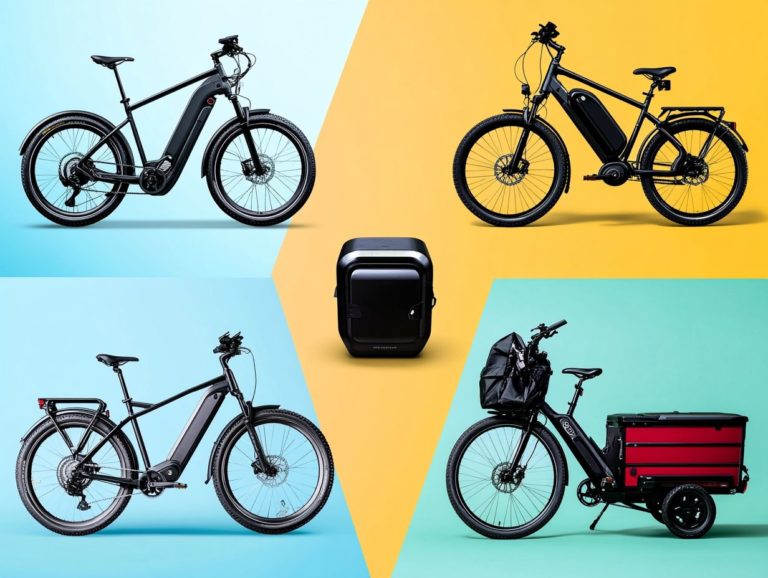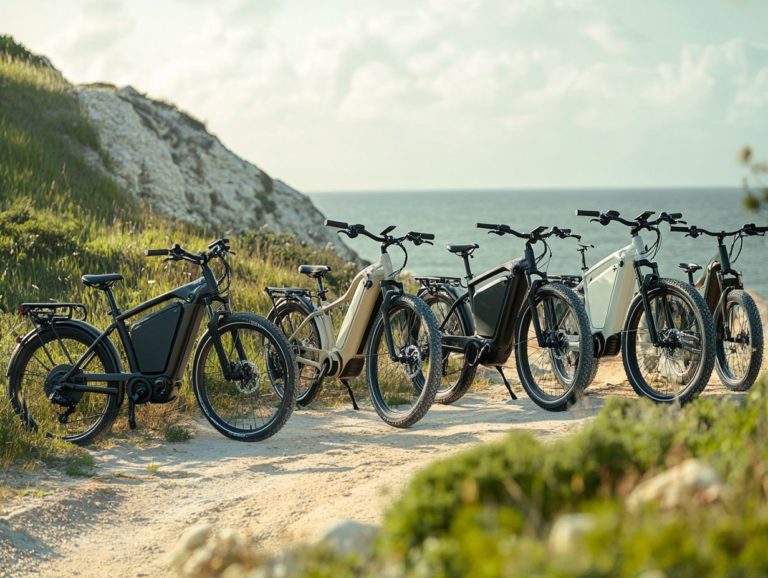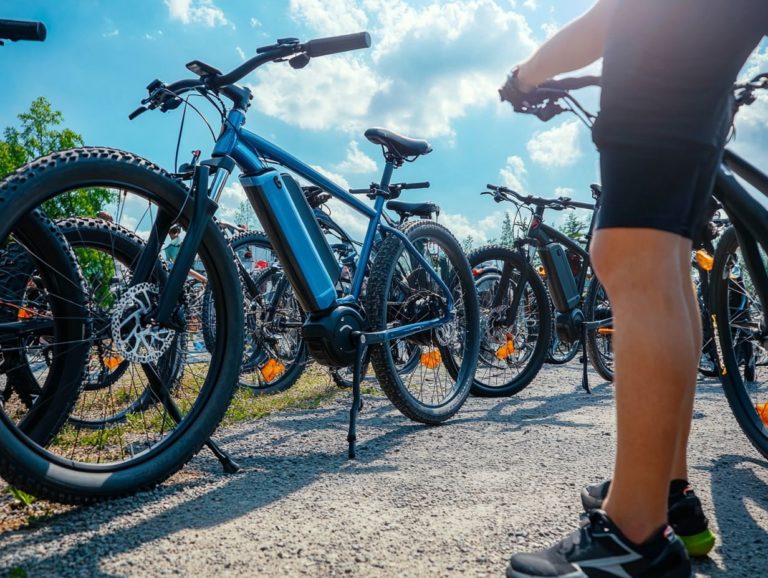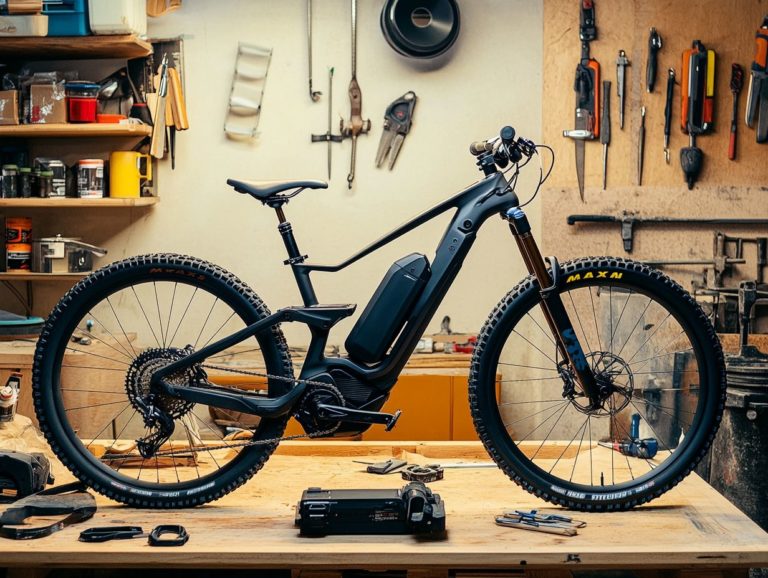How to Compare Electric Bicycle Types Effectively
Electric bicycles, or e-bikes, are revolutionizing how you commute, enjoy recreation, and stay fit. Get ready to explore the best e-bike for you!
With a variety of options available, it s essential to understand their classifications based on motor placement and pedal assistance features that help you pedal so you can select the ideal one for your needs. Factors such as battery life, motor power, and additional features can significantly influence your decision.
This guide will empower you to compare electric bicycles confidently, helping you make a smart choice that suits your lifestyle. Explore the possibilities and uncover the perfect ride waiting for you!
Contents
- Key Takeaways:
- Discover the Exciting Types of Electric Bicycles!
- Factors to Consider when Comparing Electric Bicycles
- How to Effectively Compare Electric Bicycles
- Frequently Asked Questions
- Are there different types of motors used in electric bicycles?
- How does the weight of an electric bicycle affect its performance?
- Is it necessary to spend a lot of money on a high-end electric bicycle?
Key Takeaways:
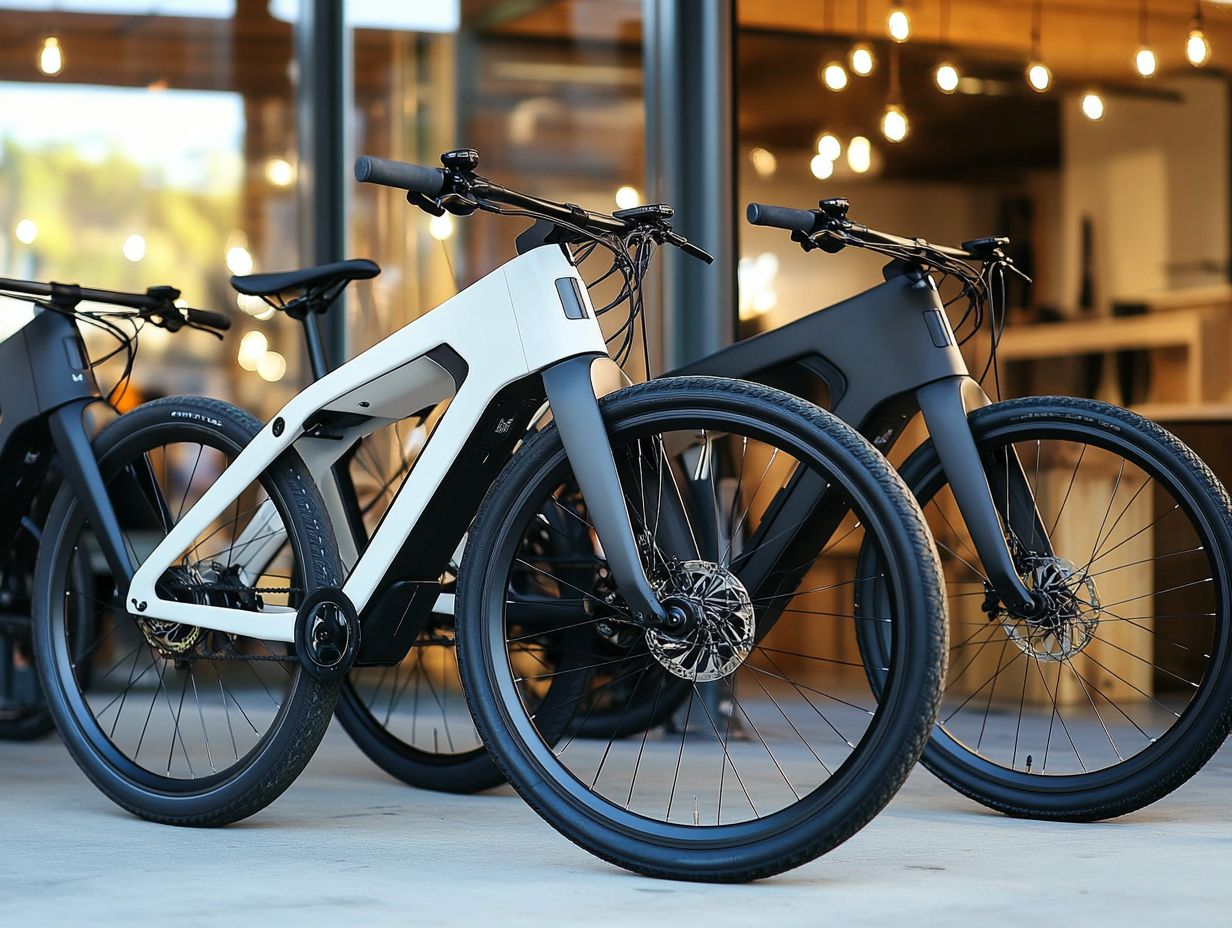
- Consider both motor placement and pedal assistance when comparing electric bicycles.
- Battery life, motor power, and features are important factors to consider.
- Research and test rides of different e-bikes, along with personal needs and preferences, will help you make an informed decision.
What are Electric Bicycles?
Electric bicycles, or e-bikes, represent a remarkable blend of traditional cycling and electric propulsion a feature that boosts your cycling efficiency allowing you to navigate your surroundings comfortably. These innovative vehicles enhance your cycling experience with features like lightweight frames and integrated motors, making them ideal for various lifestyles, whether commuting or enjoying leisurely rides.
As awareness of environmental sustainability and personal fitness grows, e-bikes are gaining popularity, providing a practical alternative to conventional transportation methods.
The story of electric bicycles dates back to the late 19th century, but they have truly taken off in recent years, especially in urban environments. E-bikes come in several categories, including city, mountain, and folding bikes, all designed to meet diverse rider needs. They offer benefits beyond mere convenience; they encourage healthier lifestyles, help reduce traffic congestion, and lower carbon footprints.
As cities continue to evolve, e-bikes are emerging as the go-to choice for urban commuters seeking efficient and eco-friendly travel options while engaging meaningfully with their surroundings.
Discover the Exciting Types of Electric Bicycles!
Electric bicycles are available in an impressive array of categories and styles, each crafted for distinct purposes and riding preferences. Whether you prefer comfort cruisers, rugged mountain e-bikes, or sleek road models, understanding these types is crucial for any potential buyer.
By grasping the nuances of different e-bike categories, you can select the electric bike that seamlessly fits your commuting needs and lifestyle, whether for daily commutes or leisurely rides. This rich diversity in e-bike styles empowers you to choose features tailored to your desires for comfort, speed, or adaptability to different terrains, ensuring your riding experience is perfectly suited to you.
Start your journey towards a healthier commute today!
Classifying by Motor Placement
Electric bicycles can be classified based on motor placement, primarily into two categories: hub motors and mid-drive motors. Each type offers distinct advantages that significantly influence your performance and riding experience.
Hub motors are located in the wheel hub, ensuring a straightforward installation and a smooth, stable ride. In contrast, mid-drive motors are situated at the bike’s crank, enhancing weight distribution and climbing capabilities. This makes them popular choices for both mountain e-bikes and commuter e-bikes.
The choice between these two types of motors profoundly impacts your overall cycling experience, especially in terms of efficiency and handling. Hub motors excel in urban environments, offering quiet operation and a simple design that s perfect for casual riders. For instance, models like the RadPower RadRover effectively utilize this technology for seamless city commutes.
On the other hand, mid-drive motors, such as those found in the Specialized Turbo Levo, are designed for performance. They are favored by enthusiasts who seek extra power for climbing steep hills or navigating rugged terrains. This distinction influences riding dynamics and also affects maintenance and battery life, as mid-drive systems typically draw more power due to their enhanced torque capabilities.
Classifying by Pedal Assistance
Electric bicycles can also be categorized based on their levels of pedal assistance, dividing them into Class 1, Class 2, and Class 3. Each class boasts unique operational characteristics and complies with various e-bike laws.
Class 1 e-bikes provide pedal assistance only when you re pedaling, with a maximum assist speed of 20 mph ideal for urban commuting. Class 2 e-bikes come with a throttle, allowing you to engage the motor without pedaling, while Class 3 e-bikes can assist you up to 28 mph, perfect for those who crave speed.
Understanding these classifications is essential to navigate the legal landscapes in different regions. Regulations often dictate where each class is permitted. Many bike lanes and multi-use paths welcome Class 1 and Class 2 e-bikes, fostering a safer riding experience. Some areas may restrict Class 3 models due to their higher speeds.
As an e-bike user, staying informed about local laws is crucial. These laws can vary significantly and impact your choice of vehicle and where you can ride safely. Familiarizing yourself with these distinctions empowers you to enjoy your electric bicycle confidently and responsibly.
Factors to Consider when Comparing Electric Bicycles
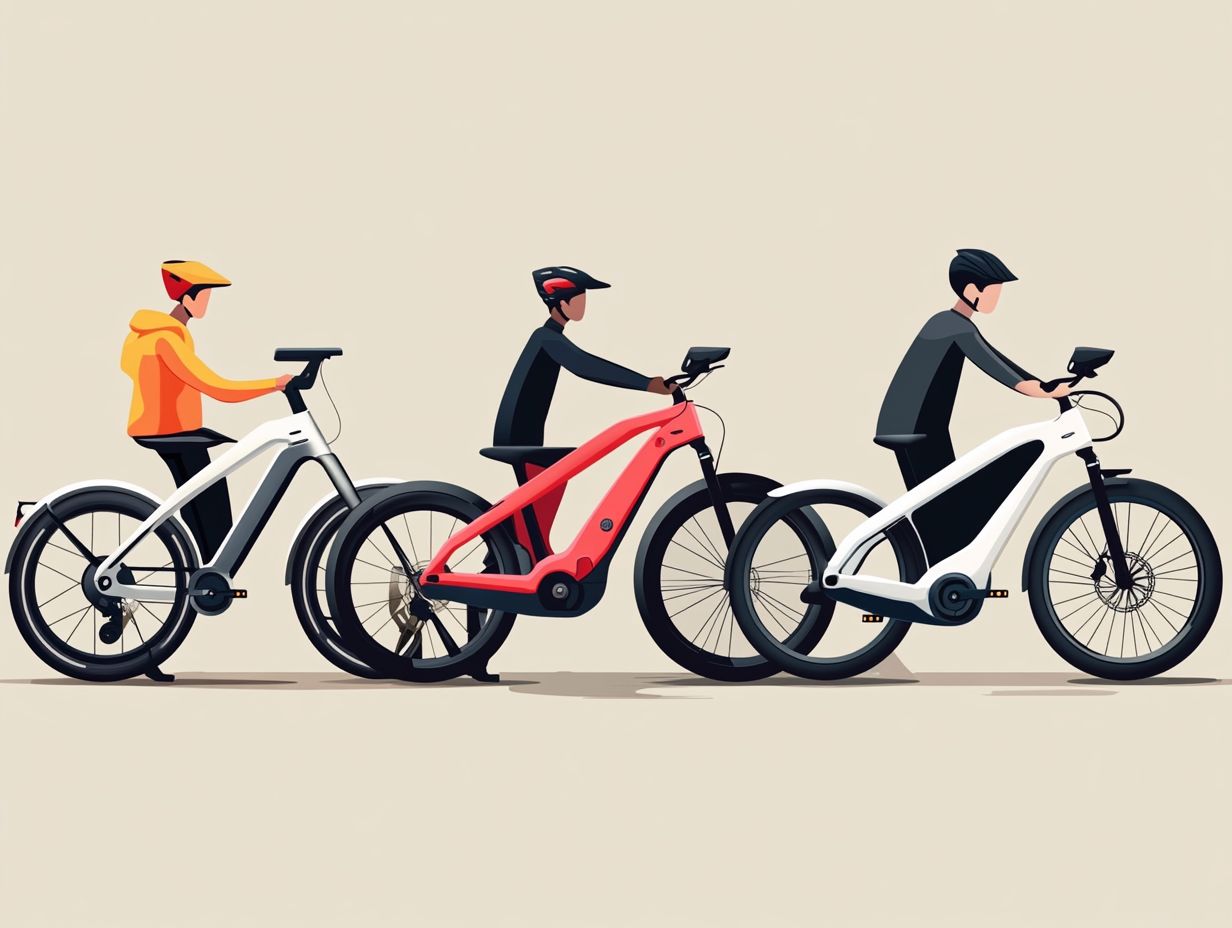
When comparing electric bicycles, let s explore key factors that will help you find your perfect e-bike. Consider e-bike battery specifications, battery life, range, motor power, and speed capabilities.
The type and capacity of the battery significantly impact your e-bike s range, determining how far you can ride on a single charge. Additionally, motor power is crucial for speed and overall performance, especially if you plan to use your e-bike for commuting or tackling mountain trails.
Don’t wait stay informed about local laws to make the best choice for your ride today!
Battery Life and Range
When selecting an electric bicycle, battery life and range are crucial factors to consider. They directly influence how far you can ride without needing to recharge.
A top-notch e-bike battery not only delivers enough power for longer commutes but also guarantees reliability on extended journeys. Whether you’re navigating off-road trails or cruising through urban landscapes, the right battery matters.
By understanding the capacity of various e-bike batteries, you can identify the fastest options available. This knowledge will help you match your specific needs with the ideal model, whether you’re considering city vs. mountain options.
Different battery technologies, such as lithium-ion and lithium-polymer, significantly impact capacity, each offering its own set of advantages. For example, lithium-ion batteries like those found in models such as the Rad Power Bikes RadRover provide an impressive balance of weight and energy density, allowing for extended rides with less frequent charging.
The capacity, measured in watt-hours (Wh) (a measure of energy capacity), typically indicates the distance an e-bike can cover on a single charge. Figures can range from 300Wh to over 1000Wh in high-performance models.
If you value versatility, consider e-bikes equipped with removable batteries. These offer added convenience and flexibility when you’re away from home.
Motor Power and Speed
The motor power of an electric bicycle is crucial in determining its speed and overall performance. This makes it an essential consideration for you as a potential buyer.
A powerful motor can elevate your riding experience, delivering the power that helps the bike climb hills. This lets you glide smoothly even on steep trails.
For urban commuters like yourself, the right motor power can be the deciding factor between seamlessly navigating through traffic and grappling with inclines or headwinds.
By understanding the various motor specifications such as wattage and torque ratings you can easily distinguish between options designed for leisurely rides, thrilling adventures, or intense workouts.
Ultimately, choosing the appropriate motor power will not only enhance your bike’s performance but also elevate your overall satisfaction with your electric biking experience.
Features and Accessories
The features and accessories of electric bicycles greatly elevate your riding experience. They offer an exquisite blend of convenience, comfort, and safety.
Top electric bikes feature:
- Integrated lights
- Adjustable seats
- Smartphone connectivity
These features transform each ride into a more enjoyable and secure adventure.
E-bike accessories like racks, fenders, and locks amplify functionality. They allow you to tailor your bike to your personal preferences and commuting needs.
Take, for instance, models like the Trek Verve+ and the Rad Power Bikes RadRover 5. They are celebrated for their bright LED lighting systems, ensuring you remain visible during evening rides and enhancing your safety on the road.
Features like pedal-assist and throttle systems create a seamless riding experience, giving you the power to conquer various terrains with effortless grace.
To enhance your journey even further, consider investing in accessories such as a robust U-lock or a helmet equipped with integrated lights. These additions not only bolster safety but also offer you peace of mind.
How to Effectively Compare Electric Bicycles
Effectively comparing electric bicycles requires a commitment to thorough research and a deep understanding of your personal needs and preferences. This guides you toward a well-informed decision.
By familiarizing yourself with the unique features of various e-bike models, you can tailor your search to discover the perfect match for your commuting style, lifestyle, and terrain preferences.
Conducting test rides is not just recommended; it s essential. This firsthand experience allows you to gauge how different e-bikes handle and perform in various conditions, ultimately ensuring a more satisfying purchase.
Don t wait! Dive in and discover which electric bike suits you best today!
Research and Test Rides
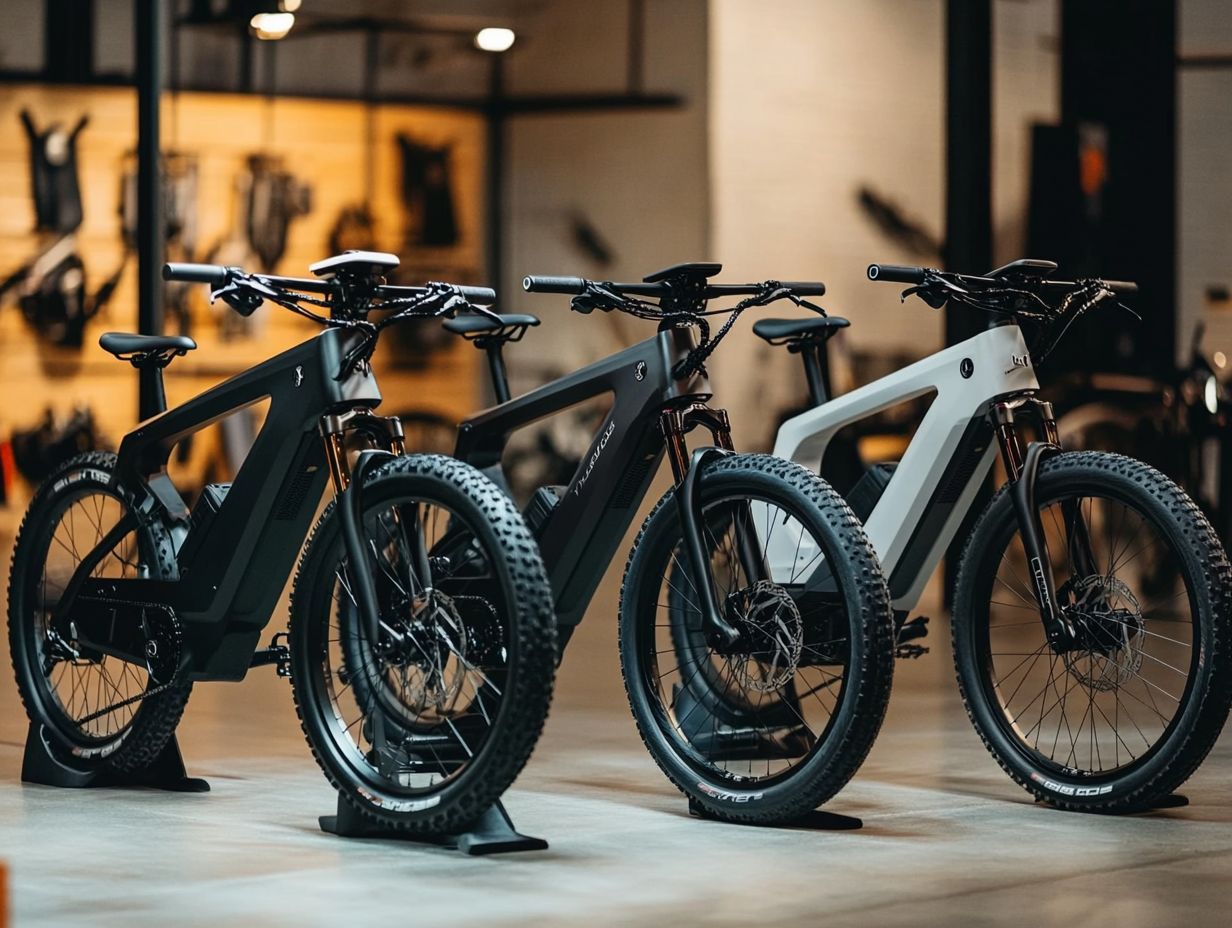
Research and test rides are essential steps in your e-bike purchasing journey, giving you the power to make informed choices based on your own experiences and preferences.
As you explore various e-bike styles from comfort cruisers to high-performance mountain models thorough research helps you grasp the unique advantages and limitations of each option.
Schedule test rides to check comfort, fit, and handling key factors that can greatly influence your riding experience.
It s wise to visit local shops or e-bike rental services that offer a diverse selection of models for your test rides.
During these experiences, notice how the bike feels while riding; aspects like weight distribution and handlebar height are crucial for an enjoyable outing.
Take note of the brakes’ responsiveness and the functionality of any electronic features.
Don t hesitate to engage with knowledgeable staff asking questions and gathering insights from their experiences can provide invaluable guidance as you embark on the quest for the perfect e-bike tailored to your needs.
Consider Personal Needs and Preferences
When selecting an electric bicycle, reflect on your personal needs. Ensure the e-bike aligns with your lifestyle.
Think about your typical riding distance, terrain, and desired speed each plays a significant role in determining the ideal e-bike for your daily commute or leisurely rides.
Consider how you commute. Are you weaving through traffic or climbing steep hills? These factors will guide your decision-making process.
If you re navigating a bustling city, you might prioritize lightweight models that offer agility and quick acceleration.
Conversely, if you re tackling longer distances, extended battery life and comfortable seating might be your top concerns.
Weather conditions also matter. Think about how they could affect your riding experience and your storage needs.
Making an Informed Decision
Making an informed decision when purchasing an electric bicycle involves knowing several key factors, including model specifications, your riding style, and local e-bike laws that could influence your experience.
By diving deeper into specifications like battery capacity, which refers to how long the battery lasts on a single charge, motor power, and weight, you can gain a clearer picture of how these elements affect performance and range.
Stay informed about local rules to ensure safety while riding.
Equipped with knowledge of market trends, you can spot innovative features and designs that elevate both comfort and usability.
By considering these aspects, you can select an electric bicycle that perfectly aligns with your commuting preferences while also supporting a sustainable lifestyle, ultimately making a positive impact on the environment.
Frequently Asked Questions
What should you look for when comparing electric bicycles?
The key factors to consider when comparing electric bicycle types effectively include battery life, motor power, weight, price, range, and overall design.
How can I determine which electric bicycle type is best for my needs?
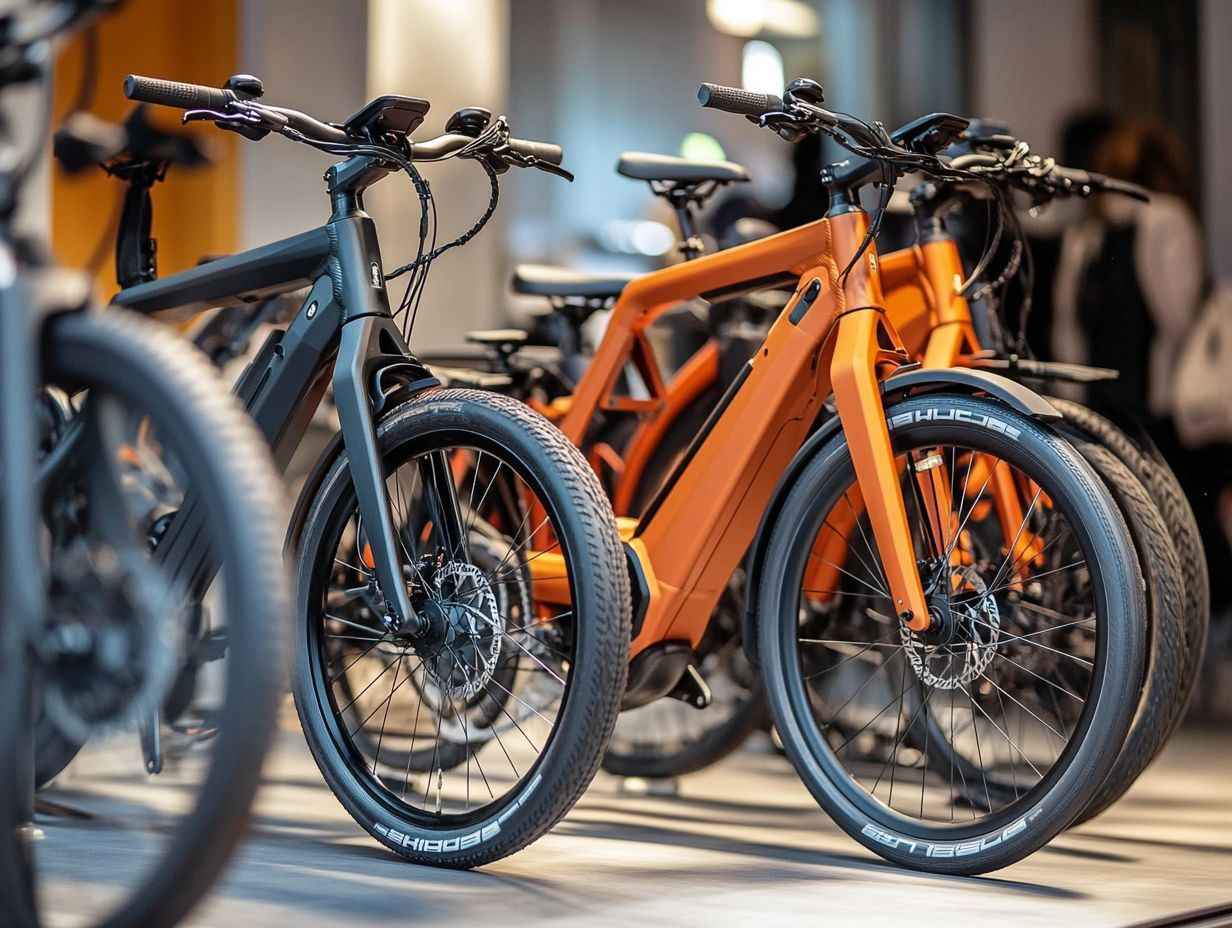
To determine the best electric bicycle type for your needs, consider your intended use, terrain, and budget. Test ride different models to get a feel for their performance.
Do all electric bicycles have the same battery life?
No, electric bicycles can have varying battery life depending on the type and quality of the battery. It’s important to compare this factor when evaluating different models.
Are there different types of motors used in electric bicycles?
Yes, there are three main types of motors: hub motors, frame motors, and friction motors. Each type offers unique benefits, so compare them carefully before choosing.
How does the weight of an electric bicycle affect its performance?
The weight of an electric bike impacts speed, range, and how easily you can handle it.
Lighter bikes generally go faster, while heavier bikes excel on rough terrain.
Is it necessary to spend a lot of money on a high-end electric bicycle?
No, you don t have to overspend.
Think about your budget it can help you find the perfect ride! You’ll discover many mid-range options packed with the features you want.


